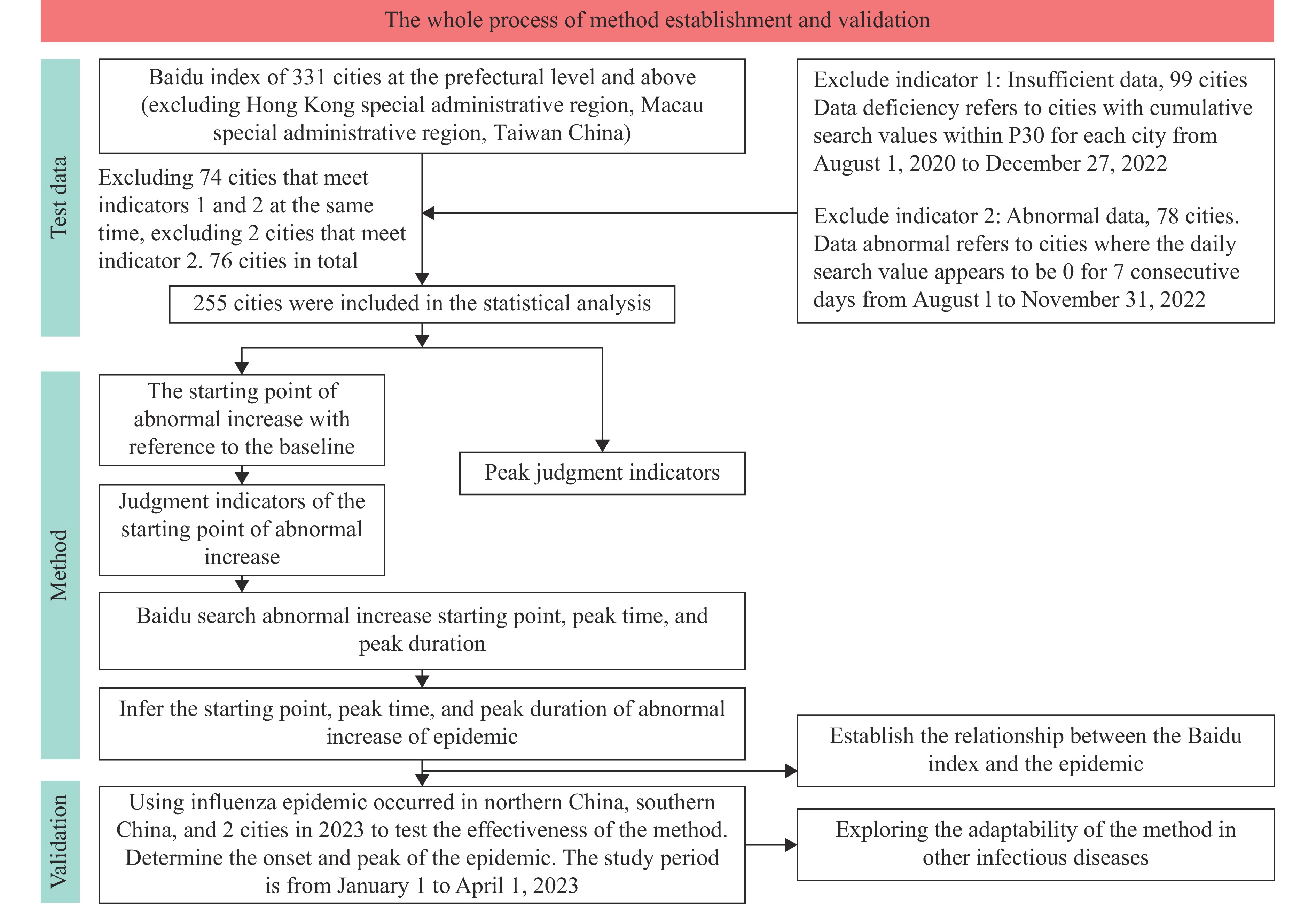2024 Vol. 6, No. 37
Infectious diseases pose a significant global health and economic burden, underscoring the critical need for precise predictive models. The Baidu index provides enhanced real-time surveillance capabilities that augment traditional systems.
Baidu search engine data on the keyword “fever” were extracted from 255 cities in China from November 2022 to January 2023. Onset and peak dates for influenza epidemics were identified by testing various criteria that combined thresholds and consecutive days.
The most effective scenario for indicating epidemic commencement involved a 90th percentile threshold exceeded for seven consecutive days, minimizing false starts. Peak detection was optimized using a 7-day moving average, balancing stability and precision.
The use of internet search data, such as the Baidu index, significantly improves the timeliness and accuracy of disease surveillance models. This innovative approach supports faster public health interventions and demonstrates its potential for enhancing epidemic monitoring and response efforts.
This study aimed to develop a rapid, visual PCR-CRISPR/Cas12-LFD method for detecting influenza A by utilizing the conserved region of the matrix protein gene.
We crafted universal degradation primers and clustered regularly interspaced short palindromic repeats RNA (CRISPR RNA, crRNA) targeting the conserved matrix protein gene of the influenza virus (IFV), integrated with lateral flow dipstick (LFD) technology. This new PCR-CRISPR/Cas12-LFD approach was designed to determine its sensitivity and specificity through the analysis of various clinical samples collected in 2023.
The developed nucleic acid assay for influenza A viruses (IAV) demonstrated a sensitivity of 10 copies/μL without cross-reactivity with other respiratory pathogens. Evaluation of 82 clinical samples showed high concordance with results from fluorescent Polymerase Chain Reaction (PCR), achieving a kappa value of 0.95.
A highly sensitive and specific PCR-CRISPR/Cas12-LFD method has been successfully established for the detection of influenza A, offering a robust tool for its diagnosis and aiding in the prevention and control of this virus.
Antigen testing has been crucial in effectively managing the coronavirus disease 2019 (COVID-19) pandemic. This study evaluated the clinical performance of a nasopharyngeal swab (NPS)-based antigen rapid diagnostic test (Ag-RDT) compared to the gold standard real-time reverse transcription-polymerase chain reaction (RT-PCR) for early detection of severe acute respiratory syndrome coronavirus 2 (SARS-CoV-2).
We developed an IgM-based rapid antigen test for early detection of SARS-CoV-2 infection. Between July 2021 and January 2022, we analyzed 1,030 NPS samples from participants at three centers in different countries, using both antigen rapid diagnostic tests (Ag-RDT) and RT-PCR.
The Ag-RDT demonstrated minimal detection limits as low as 0.1 ng/mL for recombinant N antigen and 100 TCID50/mL for heat-inactivated SARS-CoV-2 virus. Specificity assessments involving four human coronaviruses and 13 other respiratory viruses showed no cross-reactivity. The Ag-RDT assay (ALLtest) exhibited high sensitivity (93.18%–100%) and specificity (99.67%–100%) across all centers. Factors such as cycle threshold (Ct) values and the timing of symptoms since onset were influential, with sensitivity increasing at lower Ct values (<30) and within the first week of symptoms.
The ALLtest Ag-RDT demonstrated high reliability and significant potential for diagnosing suspected COVID-19 cases.
Severe fever with thrombocytopenia syndrome (SFTS) is an emerging infectious disease caused by the SFTS virus, which has a high mortality rate. Predicting the number of SFTS cases is essential for early outbreak warning and can offer valuable insights for establishing prevention and control measures.
In this study, data on monthly SFTS cases in Hubei Province, China, from 2013 to 2020 were collected. Various time series models based on seasonal auto-regressive integrated moving average (SARIMA), Prophet, eXtreme Gradient Boosting (XGBoost), and long short-term memory (LSTM) were developed using these historical data to predict SFTS cases. The established models were evaluated and compared using mean absolute error (MAE) and root mean squared error (RMSE).
Four models were developed and performed well in predicting the trend of SFTS cases. The XGBoost model outperformed the others, yielding the closest fit to the actual case numbers and exhibiting the smallest MAE (2.54) and RMSE (2.89) in capturing the seasonal trend and predicting the monthly number of SFTS cases in Hubei Province.
The developed XGBoost model represents a promising and valuable tool for SFTS prediction and early warning in Hubei Province, China.
Noroviruses are highly infectious with rapid transmission capabilities, causing illness for an average duration of 12–60 hours. In China, individuals in educational agencies may return to class 72 hours after symptom resolution.
This outbreak was precipitated by a potential source of infection in a child resuming class after a 72-hour quarantine post-symptom resolution, leading to a cluster of cases within the class.
While extending the quarantine period for children may be considered from a safety perspective, it is a challenge for educational agencies. The outbreak is deemed a low-probability event; however, further investigation into the detoxification period of asymptomatic patients is warranted.
Hospital-acquired infection (HAI) is a significant global health concern, elevating the risks of morbidity and imposing a substantial socioeconomic burden. To enhance the management of HAI, particularly in the aftermath of the coronavirus disease 2019 (COVID-19) pandemic, the Guangdong Second Provincial General Hospital (GD2H) has launched a new system called Intelligent Forest Hospital (IFH). Leveraging advancements in artificial intelligence, 5G technology, and cloud networking, the IFH implements customized indoor air quality (IAQ) control strategies tailored to different medical settings. It utilizes various intelligent disinfection devices and air purification systems. The IFH features a dynamic 3D hospital model with real-time monitoring of crucial IAQ parameters and a risk assessment ranking for clinical departments, providing timely risk alerts, communication prompts, and automatic disinfection processes. The IFH aims to effectively mitigate HAI post-COVID-19 and other future pandemics, ensuring a safe and pleasant environment for patients, hospital staff, and visitors.



 Subscribe for E-mail Alerts
Subscribe for E-mail Alerts CCDC Weekly RSS Feed
CCDC Weekly RSS Feed



